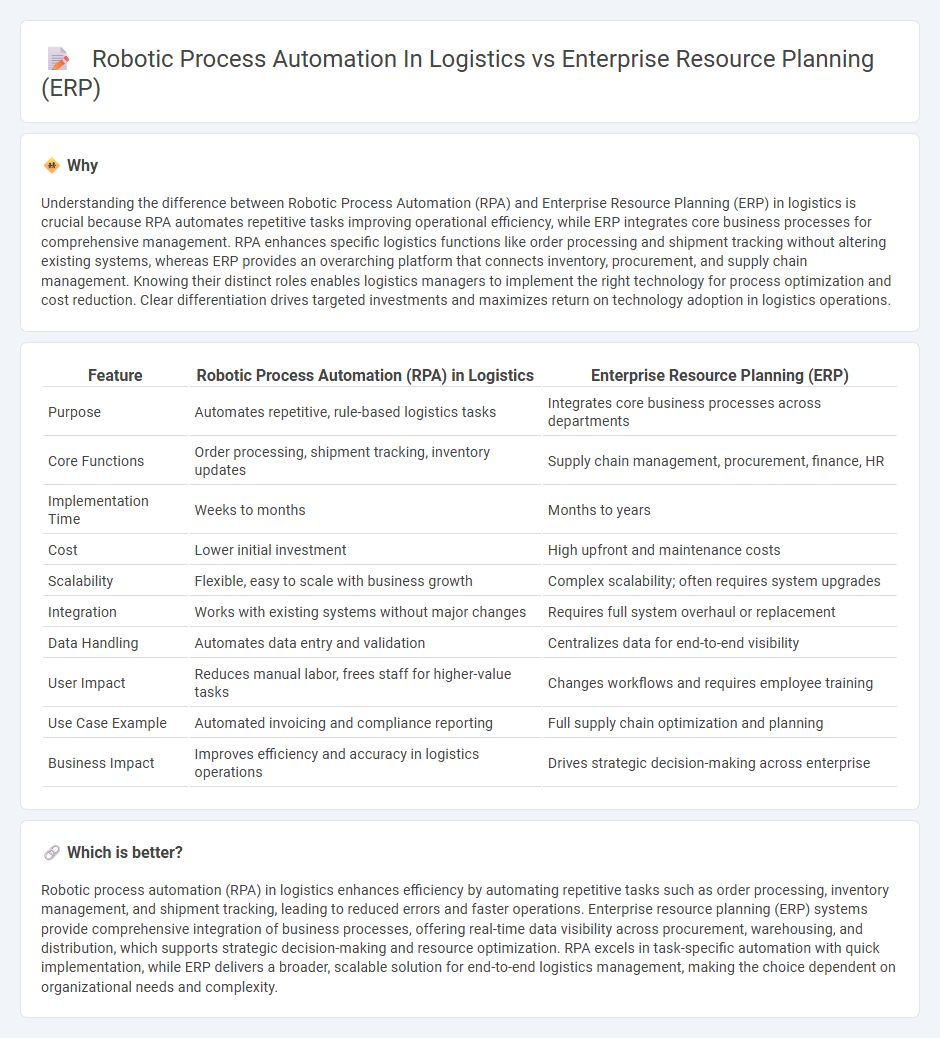
Robotic Process Automation (RPA) in logistics streamlines repetitive tasks such as inventory management, shipment tracking, and order processing by automating rule-based workflows, leading to increased operational efficiency and reduced human error. Enterprise Resource Planning (ERP) systems integrate various business processes across logistics, finance, procurement, and inventory into a centralized platform, providing comprehensive data visibility and decision-making support. Explore how combining RPA and ERP can revolutionize supply chain management and boost logistics performance.
Why it is important
Understanding the difference between Robotic Process Automation (RPA) and Enterprise Resource Planning (ERP) in logistics is crucial because RPA automates repetitive tasks improving operational efficiency, while ERP integrates core business processes for comprehensive management. RPA enhances specific logistics functions like order processing and shipment tracking without altering existing systems, whereas ERP provides an overarching platform that connects inventory, procurement, and supply chain management. Knowing their distinct roles enables logistics managers to implement the right technology for process optimization and cost reduction. Clear differentiation drives targeted investments and maximizes return on technology adoption in logistics operations.
Comparison Table
| Feature | Robotic Process Automation (RPA) in Logistics | Enterprise Resource Planning (ERP) |
|---|---|---|
| Purpose | Automates repetitive, rule-based logistics tasks | Integrates core business processes across departments |
| Core Functions | Order processing, shipment tracking, inventory updates | Supply chain management, procurement, finance, HR |
| Implementation Time | Weeks to months | Months to years |
| Cost | Lower initial investment | High upfront and maintenance costs |
| Scalability | Flexible, easy to scale with business growth | Complex scalability; often requires system upgrades |
| Integration | Works with existing systems without major changes | Requires full system overhaul or replacement |
| Data Handling | Automates data entry and validation | Centralizes data for end-to-end visibility |
| User Impact | Reduces manual labor, frees staff for higher-value tasks | Changes workflows and requires employee training |
| Use Case Example | Automated invoicing and compliance reporting | Full supply chain optimization and planning |
| Business Impact | Improves efficiency and accuracy in logistics operations | Drives strategic decision-making across enterprise |
Which is better?
Robotic process automation (RPA) in logistics enhances efficiency by automating repetitive tasks such as order processing, inventory management, and shipment tracking, leading to reduced errors and faster operations. Enterprise resource planning (ERP) systems provide comprehensive integration of business processes, offering real-time data visibility across procurement, warehousing, and distribution, which supports strategic decision-making and resource optimization. RPA excels in task-specific automation with quick implementation, while ERP delivers a broader, scalable solution for end-to-end logistics management, making the choice dependent on organizational needs and complexity.
Connection
Robotic Process Automation (RPA) in logistics streamlines repetitive tasks such as inventory management, order processing, and shipment tracking, directly enhancing the efficiency of Enterprise Resource Planning (ERP) systems by automating data entry and synchronization across modules. RPA integration within logistics ERP enables real-time data accuracy, reduces human errors, and accelerates supply chain operations, optimizing resource allocation and cost management. This synergy between RPA and ERP boosts overall operational performance and scalability in complex logistics environments.
Key Terms
Integration
Enterprise resource planning (ERP) systems centralize logistics operations by integrating inventory management, order processing, and supply chain data into a single platform for real-time visibility and decision-making. Robotic process automation (RPA) enhances logistical workflows by automating repetitive tasks such as data entry, shipment tracking, and invoice processing without altering core ERP systems. Explore the distinct integration capabilities of ERP and RPA to optimize logistics efficiency and streamline operational processes.
Workflow Automation
Enterprise Resource Planning (ERP) integrates core logistics functions such as inventory management, order processing, and supply chain coordination into a unified system, optimizing workflow by providing real-time data visibility and process standardization. Robotic Process Automation (RPA) enhances logistics workflows by automating repetitive tasks like data entry, shipment tracking, and invoice processing, increasing accuracy and reducing operational costs. Explore how combining ERP and RPA drives more efficient workflow automation in logistics for competitive advantage.
Scalability
Enterprise Resource Planning (ERP) systems centralize and standardize logistics operations, offering scalable solutions that integrate inventory, order management, and supply chain processes across multiple sites. Robotic Process Automation (RPA) enhances scalability by automating repetitive, rule-based tasks within logistics workflows, enabling rapid adaptation to fluctuating volumes without extensive system modifications. Explore how combining ERP and RPA can maximize scalability and efficiency in logistics operations.
Source and External Links
Enterprise resource planning - ERP is the integrated management of main business processes in real time, using software and technology to collect, store, manage, and interpret data across various departments, improving efficiency and coordination within an organization.
What is Enterprise Resource Planning (ERP)? - ERP software systems manage and streamline business functions such as finance, HR, supply chain, and manufacturing through integrated modules sharing a common database to reduce resources and data silos.
What is ERP? A Comprehensive Guide - ERP automates business processes by centralizing data from departments like accounting, sales, and HR into one system, enabling improved visibility, analytics, and efficiency across the organization.
 dowidth.com
dowidth.com